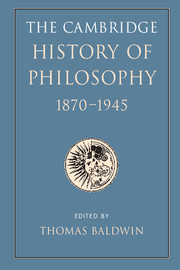Book contents
- Frontmatter
- Contents
- List of contributors
- Introduction
- I 1870–1914
- 1 Positivism, Idealism, and Pragmatism
- 2 Psychology and Philosophy
- 3 Logic, mathematics, and judgement
- 9 Logic: revival and reform
- 10 Foundations of mathematics
- 11 Theories of judgement
- 12 The logical analysis of language
- 4 Philosophy and the new physics
- 5 The idea of social science
- 6 Ethics, politics, and legal theory
- 7 Philosophy of religion and art
- Interlude
- II 1914–1945
- Biobibliographical appendix
- Bibliography
- INDEX
- References
10 - Foundations of mathematics
from 3 - Logic, mathematics, and judgement
Published online by Cambridge University Press: 28 March 2008
- Frontmatter
- Contents
- List of contributors
- Introduction
- I 1870–1914
- 1 Positivism, Idealism, and Pragmatism
- 2 Psychology and Philosophy
- 3 Logic, mathematics, and judgement
- 9 Logic: revival and reform
- 10 Foundations of mathematics
- 11 Theories of judgement
- 12 The logical analysis of language
- 4 Philosophy and the new physics
- 5 The idea of social science
- 6 Ethics, politics, and legal theory
- 7 Philosophy of religion and art
- Interlude
- II 1914–1945
- Biobibliographical appendix
- Bibliography
- INDEX
- References
Summary
INTRODUCTION
It is uncontroversial to say that the period in question saw more important changes in the philosophy of mathematics than any previous period of similar length in the history of philosophy. Above all, it is in this period that the study of the foundations of mathematics became partly a mathematical investigation itself. So rich a period is it, that this survey article is only the merest sketch; inevitably, some subjects and figures will be inadequately treated (the most notable omission being discussion of Peano and the Italian schools of geometry and logic). Of prime importance in understanding the period are the changes in mathematics itself that the nineteenth century brought, for much foundational work is a reaction to these, resulting either in an expansion of the philosophical horizon to incorporate and systematise these changes, or in articulated opposition. What, in broad outline, were the changes?
First, traditional subjects were treated in entirely new ways. This applies to arithmetic, the theory of real and complex numbers and functions, algebra, and geometry. (a) Some central concepts were characterised differently, or properly characterised for the first time, for example, from analysis, those of continuity (Weierstrass, Cantor, Dedekind) and integrability (Jordan, Lebesgue, Young), from geometry, that of congruence (Pasch, Hilbert), and geometry itself was recast as a purely synthetic theory (von Staudt, Pasch, Hilbert). (b) Theories were treated in entirely new ways, for example, as axiomatic systems (Pasch, Peano and the Italian School, Hilbert), as structures (Dedekind, Hilbert), or with entirely different primitives (Riemann, Cantor, Frege, Russell).
- Type
- Chapter
- Information
- The Cambridge History of Philosophy 1870–1945 , pp. 128 - 156Publisher: Cambridge University PressPrint publication year: 2003



